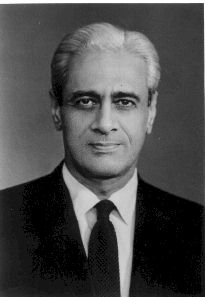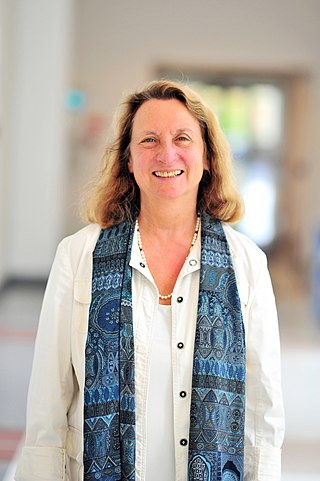
Osborne Reynolds was an Irish-born British innovator in the understanding of fluid dynamics. Separately, his studies of heat transfer between solids and fluids brought improvements in boiler and condenser design. He spent his entire career at what is now the University of Manchester.

Satish Dhawan was an Indian mathematician and aerospace engineer, widely regarded as the father of experimental fluid dynamics research in India. Born in Srinagar, Dhawan was educated in India and further on in United States. Dhawan was one of the most eminent researchers in the field of turbulence and boundary layers, leading the successful and indigenous development of the Indian space programme. He succeeded M. G. K. Menon, as the third chairman of the Indian Space Research Organisation (ISRO) in 1972. The second launch pad of ISRO, Satish Dhawan space centre is named after him. He is greatly regarded as the man behind A. P. J. Abdul Kalam.

Leo Philip Kadanoff was an American physicist. He was a professor of physics at the University of Chicago and a former president of the American Physical Society (APS). He contributed to the fields of statistical physics, chaos theory, and theoretical condensed matter physics.

The Courant Institute of Mathematical Sciences is the mathematics research school of New York University (NYU). Founded in 1935, it is named after Richard Courant, one of the founders of the Courant Institute and also a mathematics professor at New York University from 1936 to 1972, and serves as a center for research and advanced training in computer science and mathematics. It is located on Gould Plaza next to the Stern School of Business and the economics department of the College of Arts and Science.

Howard Alvin Stone is the Donald R. Dixon '69 and Elizabeth W. Dixon Professor in Mechanical and Aerospace Engineering at Princeton University. His field of research is in fluid mechanics, chemical engineering and complex fluids. He became an Editor of the Annual Review of Fluid Mechanics in 2021.

Roddam Narasimha FRS was an Indian aerospace scientist and fluid dynamicist. He was a professor of Aerospace Engineering at the Indian Institute of Science (1962–1999), director of the National Aerospace Laboratories (1984–1993) and the chairman of the Engineering Mechanics Unit at Jawaharlal Nehru Centre for Advanced Scientific Research. He was the DST Year-of-Science Chair Professor at JNCASR and concurrently held the Pratt & Whitney Chair in Science and Engineering at the University of Hyderabad. Narasimha was awarded the Padma Vibhushan, India's second-highest civilian award, in 2013. for his contributions to advance India's aerospace technology.
Howard Wilson Emmons (1912–1998) was an American professor in the department of Mechanical Engineering at Harvard University. During his career he conducted original research on fluid mechanics, combustion and fire safety. Today he is most widely known for his pioneering work in the field of fire safety engineering. He has been called "the father of modern fire science" for his contribution to the understanding of flame propagation and fire dynamics. He also helped design the first supersonic wind tunnel, identified a signature of the transition to turbulence in boundary layer flows, and was the first to observe compressor stall in a gas turbine compressor. He initiated studies on diffusion flames inside a boundary layer, and Emmons problem is named after him. He was eventually awarded the Timoshenko Medal by the American Society of Mechanical Engineers and the 1968 Sir Alfred Egerton Gold Medal from The Combustion Institute.
Stanley Corrsin was an American physicist, fluid dynamicist, and Theophilus Halley Smoot Professor of Engineering at the Johns Hopkins University. He was known for his contributions in the field of fluid dynamics in general and turbulence in particular. He was a recipient of Fluid Dynamics Prize in 1983. Corrsin died of cancer on 2 June 1986 at the age of 66.
Michael J. Shelley is an American applied mathematician who works on the modeling and simulation of complex systems arising in physics and biology. This has included free-boundary problems in fluids and materials science, singularity formation in partial differential equations, modeling visual perception in the primary visual cortex, dynamics of complex and active fluids, cellular biophysics, and fluid-structure interaction problems such as the flapping of flags, stream-lining in nature, and flapping flight. He is also the co-founder and co-director of the Courant Institute's Applied Mathematics Lab.
Russell James Donnelly was a Canadian-American physicist known for his work on classical and quantum fluid dynamics. He connected the fields of low temperature physics and fluid turbulence.

Elaine Surick Oran is an American physical scientist and is considered a world authority on numerical methods for large-scale simulation of physical systems. She has pioneered computational technology to solve complex reactive flow problems, unifying concepts from science, mathematics, engineering, and computer science in a new methodology. An incredibly diverse range of phenomena can be modeled and better understood using her techniques for numerical simulation of fluid flows, ranging from the tightly grouped movements of fish in Earth's oceans to the explosions of far-flung supernovae in space. Her work has contributed significantly to the advancement of the engineering profession.
Mark Samuel Nelkin is a theoretical physicist at the Cornell University.

George Em Karniadakis is a professor of applied mathematics at Brown University. He is a Greek-American researcher who is known for his wide-spectrum work on high-dimensional stochastic modeling and multiscale simulations of physical and biological systems, and is a pioneer of spectral/hp-element methods for fluids in complex geometries, general polynomial chaos for uncertainty quantification, and the Sturm-Liouville theory for partial differential equations and fractional calculus.
Raymond Ethan Goldstein FRS FInstP is the Alan Turing Professor of Complex Physical Systems in the Department of Applied Mathematics and Theoretical Physics (DAMTP) at the University of Cambridge and a Fellow of Churchill College, Cambridge.
Maurizio Porfiri is an engineering professor, mostly noted for his work with robotic fish and aquatic research. His research revolves around modeling and control of complex systems, with applications from mechanics to behavior, public health, and robotics. He is an Institute Professor of Mechanical and Aerospace Engineering and Biomedical Engineering at the New York University Tandon School of Engineering. He is also part of the core faculty of New York University's Center for Urban Science and Progress. In 2022, he was appointed the director of the Center for Urban Science and Progress.
Alexander L. Yarin is a Soviet-Israeli-American applied physicist and engineer, from 2006 and currently Distinguished Professor at University of Illinois, Chicago and an Elected Fellow of the American Physical Society.
Gustavo A. Stolovitzky is an Argentine-American computational systems biologist. He was the CSO of Sema4 and then of GeneDx until December 2023. Between 1998 and 2021 he was a researcher and executive at IBM Research. At IBM he served in several roles including Founding Chair of the Exploratory Life Sciences Council and Director of the Translational Systems Biology and Nano-Biotechnology Program at IBM Research. From 2013 to 2018 he was Adjunct professor of Genetics and Genomic Sciences at the Icahn School of Medicine at Mount Sinai and from 2007 he has been an Adjunct Associate Professor of Biomedical Informatics at Columbia University. His research has been cited more than 29,000 times

Lian-Ping Wang is a mechanical engineer and academic, most known for his work on computational fluid dynamics, turbulence, particle-laden flow, and immiscible multiphase flow, and their applications to industrial and atmospheric processes. He is the Chair Professor of Mechanics and Aerospace Engineering at the Southern University of Science and Technology in China, Professor of Mechanical Engineering, and Joint Professor of Physical Ocean Science and Engineering at University of Delaware.









